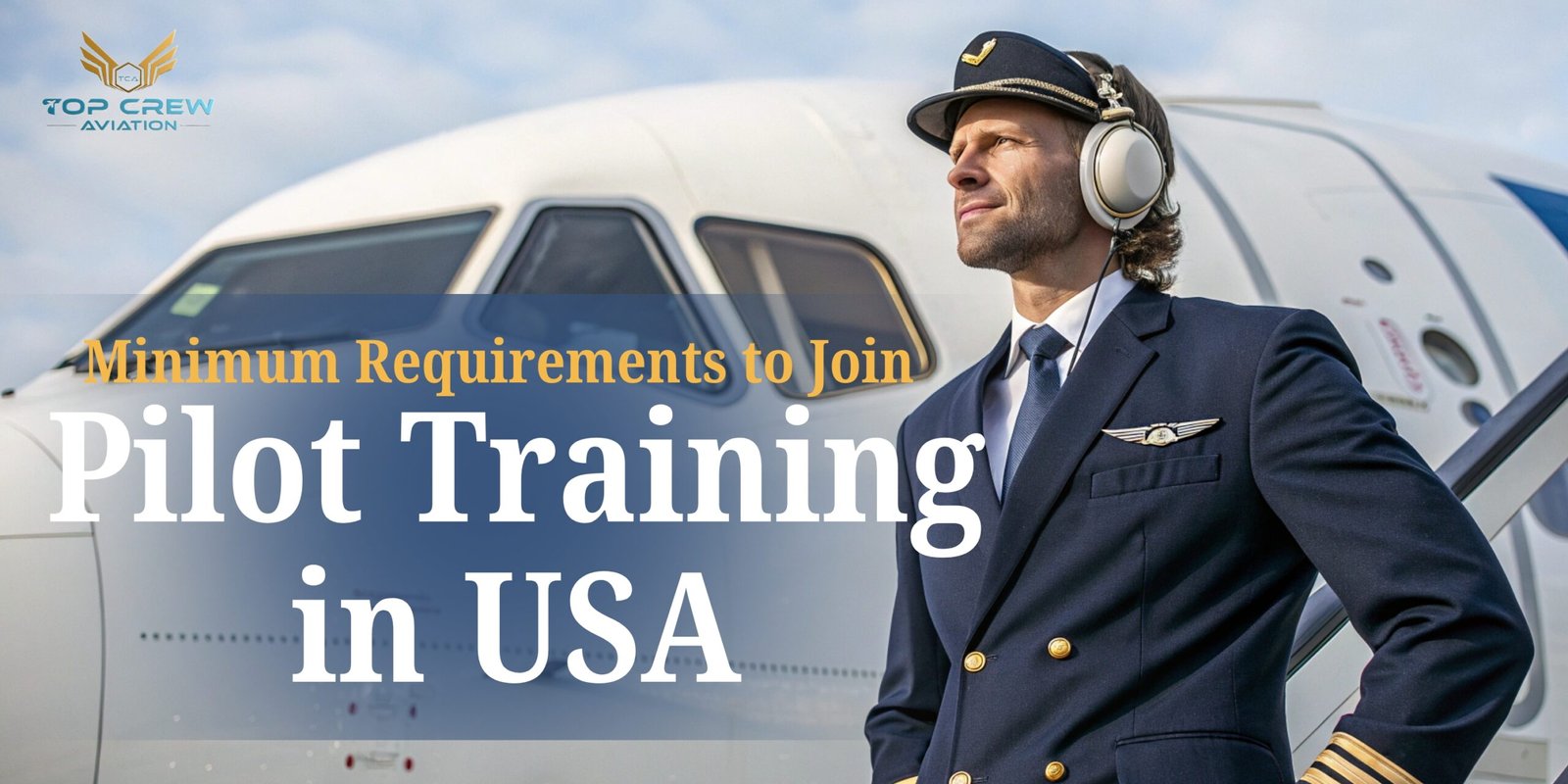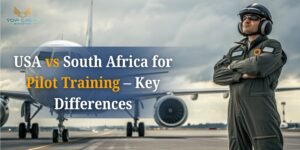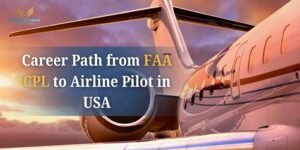Introduction
Flying has always been a dream career for many students worldwide, and the USA is one of the top destinations for aspiring pilots. With world-class training facilities, internationally recognized FAA licenses, and excellent career opportunities, Pilot Training in USA has become a popular choice. However, before starting your journey, it’s important to understand the Basic Pilot Training Requirements, eligibility, costs, and career path. This blog will guide you step by step.
Basic Minimum Requirements for Pilot Training in USA
Before joining any Pilot Course in USA, students must meet certain eligibility criteria. These requirements ensure that every candidate is physically, mentally, and academically prepared for the challenges of flight training.
Age Requirement
- Minimum 16 years for Private Pilot License (PPL) – This is the entry-level license where students learn the basics of flying.
- Minimum 18 years for Commercial Pilot License (CPL) – At this age, students can begin training to fly commercially and earn money as a pilot.
- Minimum 23 years for Airline Transport Pilot License (ATPL) – This is the highest level of certification and allows you to become an airline captain.
Age is one of the most important Basic Pilot Training Requirements, as it defines which stage of training you are eligible to begin.
Education Requirement
A high school diploma or equivalent is usually the minimum Pilot Course education needed to start training. While Mathematics and Physics are not mandatory in all schools, having a background in these subjects helps students understand aerodynamics, navigation, and flight calculations much faster. Some universities also offer aviation degree programs that combine academics with flight training.
Medical Fitness Requirement
All students must pass an FAA-approved medical examination. Depending on the license you are pursuing, you will need either:
- Class 1 Medical Certificate – Required for Commercial Pilot License (CPL) and Airline Transport Pilot License (ATPL).
- Class 2 Medical Certificate – Sufficient for Private Pilot License (PPL).
Medical fitness ensures you are physically and mentally capable of handling the responsibilities of flying an aircraft.
English Language Proficiency
Since aviation communication worldwide is in English, all international students must prove fluency in the language. FAA standards require that students understand, speak, and read English clearly. Some schools may ask for TOEFL/IELTS scores, especially for non-native speakers.
Visa Requirement
International students must obtain an M-1 Visa to undergo Pilot Training in USA. This student visa is specifically for vocational and non-academic training programs, including flight schools. Visa approval also requires proof of funds, acceptance letters from flight schools, and valid travel documents.
These points cover the Pilot Training Eligibility for most flight schools across the United States. Meeting these basic minimum requirements is the first step toward building a successful aviation career.
Different Levels of Pilot Course in USA
The Pilot Course in USA is not a single program, but a series of training levels that students progress through step by step. Each stage builds on the previous one and prepares you for more advanced flying skills. Let’s look at the main levels in detail:
- Private Pilot License (PPL)
This is the first stage of pilot training. At this level, you learn the fundamentals of flying, including take-off, landing, navigation, and basic maneuvers. A PPL allows you to fly for personal use but not for commercial purposes. It is the foundation of every professional pilot’s career.
- Commercial Pilot License (CPL)
The CPL is the professional entry point in aviation. With this license, you can fly aircraft for commercial purposes and start earning money. The training covers advanced maneuvers, cross-country flying, and in-depth flight planning. CPL graduates are eligible to apply for airline jobs, charter flights, or cargo operations.
- Instrument Rating (IR)
Instrument Rating is an additional qualification that allows pilots to fly in different weather conditions. Instead of relying on visual cues, you learn to use instruments inside the cockpit for navigation and control. This rating is critical for professional pilots since airlines operate in all weather conditions.
- Multi-Engine Rating
Most commercial airlines and cargo companies use multi-engine aircraft. This stage of training teaches you how to handle airplanes with more than one engine, including managing engine failures and balancing aircraft performance. A multi-engine rating is often mandatory for pilots who want to work with major airlines.
- Airline Transport Pilot License (ATPL)
The ATPL is the highest level of certification in aviation. It qualifies you to become a captain of an airline. To apply, you must meet specific age, flight hours, and experience requirements. ATPL holders have the responsibility of commanding large aircraft and leading a flight crew.
The structured levels of a Pilot Course in USA ensure that students move forward in a logical and professional way. Starting from the basics and progressing to advanced skills, this pathway builds both confidence and expertise, preparing you for a rewarding aviation career.
Education
While a high school certificate is the minimum Pilot Course education, many flight schools recommend having knowledge in Mathematics, Physics, and English. Some universities in the USA also offer aviation degree programs combined with flight training, which can be a strong advantage in the aviation job market.
Additional Eligibility Factors for Pilot Training in the USA
Apart from the basic pilot training requirements, there are some extra eligibility factors that play a very important role in shaping a successful pilot career. Let’s understand them in detail:
Good Physical and Mental Health
A pilot’s job requires high alertness, focus, and stamina. Therefore, maintaining excellent physical fitness and stable mental health is mandatory. You will also need to clear medical examinations conducted by aviation authorities to prove your fitness for flying.
No Serious Criminal Record
Pilots carry huge responsibility for the safety of passengers and crew. Hence, candidates must have a clean background. A serious criminal record can prevent you from getting a license or job opportunities in reputed airlines.
Strong Decision-Making Ability
In aviation, every second counts. A good pilot must be capable of making quick and correct decisions, especially during emergencies. Airlines look for candidates with strong problem-solving, leadership, and presence of mind.
Financial Stability
Pilot training in the USA is a big investment. Students need financial stability to cover expenses like tuition fees, flying hours, accommodation, and living costs. Having a clear financial plan or support ensures smooth training without unnecessary stress.
In short, these factors—along with the basic training requirements—ensure that a student is fully prepared for the challenges and responsibilities of becoming a professional pilot.
Types of Pilot Training Programs in USA
When planning for Pilot Training in USA, students can choose between two main types of programs:
- Modular Training – Step-by-step training (PPL → CPL → IR → ATPL). You can complete each stage as per your budget and time.
- Integrated Training – A full-time structured program where you progress directly from zero experience to CPL or ATPL.
Both options have their pros and cons, and students should select based on personal goals. These choices highlight the different Pilot Training Programs Types in USA.
Documents Required for Pilot Training in the USA
Before you begin your Pilot Training in the USA, you need to arrange some important documents. Having these ready in advance makes the admission process smooth and hassle-free. Let’s look at them in detail:
Valid Passport
A passport is your primary identification document for traveling and staying in the USA. Make sure your passport has sufficient validity (at least 6 months beyond your intended stay).
Academic Certificates (10th/12th or Higher)
Most flight schools require proof of your educational background. Your 10th and 12th certificates (or higher qualifications) help verify your eligibility for training programs. Some schools may prefer students with strong subjects in Maths and Physics.
Proof of English Proficiency
Since aviation is conducted in English worldwide, many schools ask for English language proficiency proof. Tests like TOEFL or IELTS may be required, depending on the training academy’s rules.
FAA Medical Certificate
Every student pilot must obtain an FAA-approved medical certificate to prove they are fit to fly. This includes vision, hearing, and overall health checks conducted by authorized medical examiners.
Proof of Funds (Bank Statements)
Training in the USA involves significant expenses. You need to show bank statements or financial documents proving that you can cover your tuition fees, accommodation, and living costs during the course.
Visa Documents (M-1 Visa for Training)
For pilot training, international students usually require an M-1 visa. This visa is specifically for vocational training courses. Make sure you have all the necessary paperwork, including your I-20 form from the flight school.
Cost & Duration Overview
The Pilot Training Cost & Duration in the USA depends on the program and school.
- Private Pilot License (PPL): $10,000 – $15,000 (3–6 months)
- Commercial Pilot License (CPL): $30,000 – $50,000 (6–12 months)
- Full Training to ATPL: $60,000 – $80,000 (12–24 months)
Additional expenses include accommodation, living costs, visa fees, and insurance. While costs are high, the USA provides high-quality training and faster completion compared to other countries.
Top Aviation Academies in USA – Scholarships & Financial Aid
The USA has some of the world’s best flight schools. Popular choices include:
- Embry-Riddle Aeronautical University
- ATP Flight School
- Phoenix East Aviation
- CAE Aviation
Many schools offer scholarships and financial aid for international students. These opportunities can significantly reduce expenses for eligible candidates. Choosing the right academy is key when considering the Top Aviation Academies in USA.
How Top Crew Aviation Can Help in Your Pilot Training in the USA
Choosing to pursue Pilot Training in the USA is a big decision, and having the right guidance can make the entire process much easier. Top Crew Aviation ensures that students not only get admission but also receive complete support at every stage of their journey. Here’s how we help:
Personalized Counseling for Choosing the Right Academy
Every student has different career goals and budgets. At Top Crew Aviation, we provide one-on-one counseling sessions to understand your needs and help you select the best flight school in the USA that matches your aspirations.
Assistance in Visa and Documentation Process
The visa process and paperwork can often be confusing. We assist you with M-1 visa applications, I-20 forms, financial proofs, and other required documents, ensuring your application is smooth and error-free.
Guidance on Scholarships and Financial Planning
Pilot training requires a significant financial investment. Our team guides you through scholarship opportunities, loan options, and financial planning strategies, so you can manage your training expenses with confidence.
Support in Clearing FAA Exams and Medical Requirements
To become a licensed pilot in the USA, you must clear the FAA medical examinations and written tests. We provide study resources, mentorship, and guidance to help you clear these requirements successfully.
Career Counseling After Training Completion
Your journey doesn’t end with training. We also provide career counseling, airline interview preparation, and job guidance, helping you transition from a student pilot to a professional aviator.
At Top Crew Aviation, our mission is to ensure that every student achieves their dream of becoming a successful pilot. From admission to career placement, we stand by you at every step of the way.
Career Path After Training
After completing Pilot Training in the USA, you can choose from:
- Regional Airlines – Start your career with domestic routes.
- International Airlines – Fly long-haul and global routes.
- Cargo Airlines – Transport goods and earn valuable flying hours.
- Corporate/Private Jets – Fly business executives and VIPs.
- Flight Instructor – Train new students and build more hours.
A USA license is globally recognized, giving you career opportunities in many countries.
Challenges & Tips for Students
Common Challenges
- Flight delays due to weather conditions
- Cultural adjustments in a new country
- Managing high training costs
- Staying consistent with flight hours & exams
Tips to Overcome
- Plan your finances early
- Stay disciplined and focused
- Keep medical fitness in check
- Take help from mentors & institutions like Top Crew Aviation
Conclusion
Starting your journey in aviation is a big step, and the USA remains one of the best places to achieve your dream. By understanding the Basic Pilot Training Requirements, preparing the right Documents Required, selecting from different Pilot Training Programs Types in USA, and managing the Pilot Training Cost & Duration in USA, students can build a clear roadmap to success.With the support of Top Crew Aviation, aspiring pilots can confidently pursue Pilot Training in USA and unlock a global career path.
Suggestion Blog URL:-
How to Become a Pilot in USA
Why USA is the Best Destination for Pilot Training



